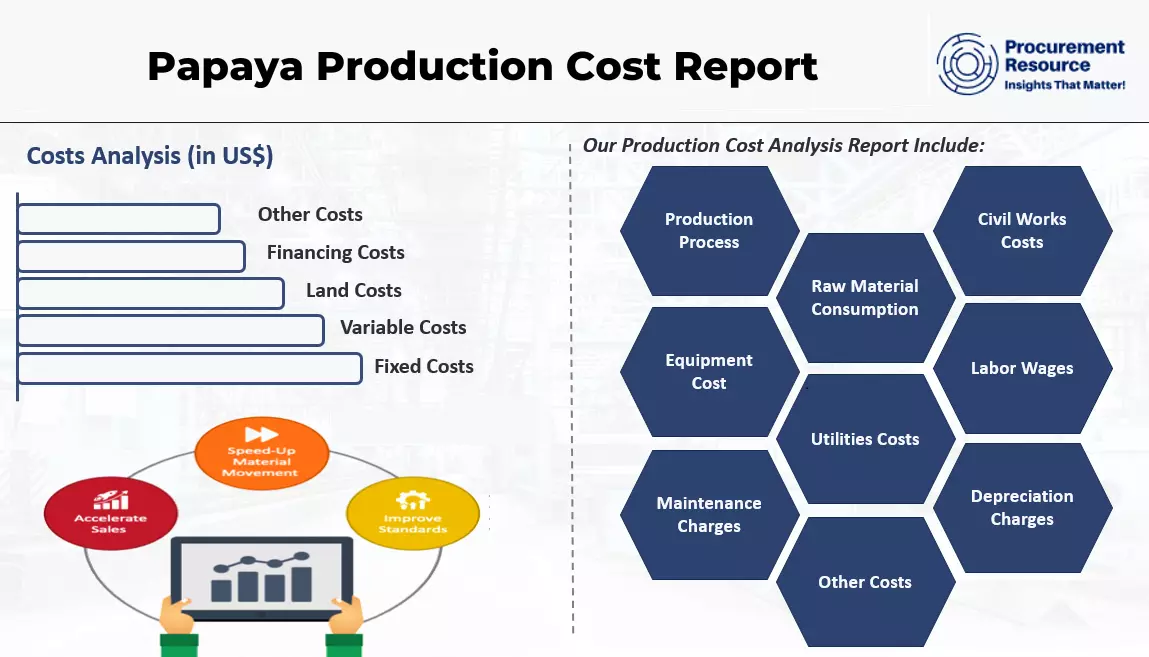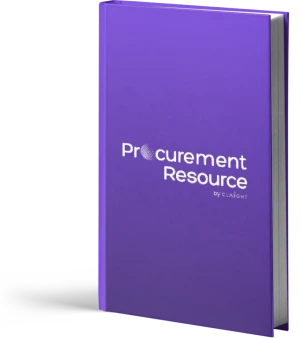Papaya Production Cost Reports
Agriculture, Farming and Commodity
The report provides a detailed production cost analysis for papaya. It encompasses all critical aspects necessary for papaya production, including the cost of papaya production, papaya production cost model, and other extensive details. These encompass production processes, raw material requirements, utility requirements, infrastructure needs, machinery and technology requirements, manpower requirements, packaging requirements, transportation requirements, and more.

The versatile papaya finds applications in the food, skincare, and cosmetics industries. While it is predominantly consumed fresh, it is also processed for flavoring products. Recognized for its health benefits, papaya is antioxidant-rich and has excellent hydration properties. Its extracts and flavors are used in creating various products, including shampoos, creams, moisturizers, lip care products, and more.
Papaya contains specific purified plant proteins like papain and chymopapain, which find applications in hair care and body care products. Moreover, papain, which is an extract obtained from papaya, is used in certain hair conditioners as a meat tenderizer and is even added to chewing gums and dentifrices, among other products.
The market for papaya is driven by its demand as a nutritive fruit variety for food, healthcare, body care, and cosmetic products. Its usage in the production of food products, including nutritional bars, iced tea powder, candies, and beverages such as fruit cocktails, etc., increases its demand in the market.
Papaya is known to contain papain. Applications of papain in the preparation of lotions, providing moisturization and hydration, amplifies the demand for papaya in body care products. Its applications in the production of shampoos, lotions, and cosmetics increase its demand in the cosmetics industry.
Industrial papaya procurement is chiefly influenced by its demand in the food, healthcare, and cosmetics industries along with its production across regions including India, etc., governing its procurement on a large scale. Hence, changes in its demand, along with its supply across borders and market prices, have a strong impact on its procurement around the globe.
Raw Material for Papaya Production
According to the papaya production cost report, the key raw material for papaya production includes papaya seeds.
Production Process of Papaya
The extensive papaya production cost report consists of the following industrial production process:
- By Agricultural Method: Papaya is a fruit, produced by agricultural method. The seeds of the papaya fruit are sown, and then harvested after 12 months.
Papaya, also known as papaw or pawpaw, is a fruit variety that mainly belongs to the Caricaceae family. The fruit is an excellent source of ascorbic acid, vitamin C, and carotenoids. It is primarily grown in tropical regions. Papayas are rich in carbohydrates and sugar, containing very little starch.
It is a low-acid fruit, with a total titratable acidity of around 0.1%, calculated as citric acid. The pH of the fruit is measured around 5.5 to 5.9, which is higher than many other tropical fruit varieties available in the market. Its appealing aroma and flavor are attributed to linalool. The plant is cultivated from its seeds, mainly in tropical regions, and thrives in a sunny climate. It can be harvested approximately six months after planting.
Papaya boasts numerous health benefits and is abundant in minerals and nutrients. It primarily contains vitamins A, C, and E. Rich in antioxidants, consistent consumption of Papaya can significantly mitigate health risks. The antioxidants in Papaya help prevent cholesterol oxidation, which can lead to various heart diseases. The fruit is also a good source of fibers and essential organic compounds such as folic acid, vital for optimal body function.
Papaya Production Cost Processes with Cost Analysis

Papaya Production by Agricultural Methods
This study analyzes Papaya Production by Agricultural Methods, covering manufacturing, process flow, operating expenses, and financial considerations.
Details: Germany - based plant Q1 2025 From $ 2499.00 USD
Product Details
| Particulars | Details |
|---|---|
| Product Name | Papaya |
| Scope | Manufacturing Process: Process Flow, Material Flow, Material Balance Raw Material and Product Specifications: Raw Material Consumption, Product and Co-product Generation Land and Site Cost: Offsites/Civil Works, Equipment Cost, Auxiliary Equipment Costs, Contingency, Engineering and Consulting Charges, Working Capital Variable Cost: Raw Material, Utilities, Other Variable Costs Fixed Cost: Labor Requirements and Wages, Overhead Expenses, Maintenance Charges, Other Fixed Costs Financing Costs: Interest on Working Capital, Interest on Loans Other Costs: Depreciation Charges, General Sales and Admin Cost |
| Currency | US$ (Data can also be provided in the local currency) |
| Pricing and Purchase Options | Basic: US$ 2499 Premium: US$ 3499 Enterprise: US$ 4799 |
| Customization Scope | The report can be customized as per the requirement of the customer |
| Post-Sale Analysts Report | 10-12 weeks of post-purchase analyst support after report delivery for any queries from the deliverable |
| Delivery Format | PDF and Excel format through email (editable version in PPT/Word format of the report can be also provided on special request) |
How does our Papaya Production Cost Report Provide Exhaustive Data and Extensive Insights?
At Procurement Resource, we not only focus on optimizing the should cost of production for Papaya but also provide our clients with extensive intel and rigorous information on every aspect of the production process. By utilizing a comprehensive cost model, we help you break down expenses related to raw materials, labor, and technology, offering clear pathways to savings. We also assist in evaluating the capital expenditure (CAPEX) and operating expenses (OPEX), which are often measured as cost per unit of production, such as USD/MT, ensuring that your financial planning is aligned with industry benchmarks.
We offer valuable insights on the top technology providers, in-depth supplier database, and best manufacturers, helping you make informed decisions to improve efficiency. Additionally, we design the most feasible layout for your production needs, ensuring the entire process runs smoothly. By minimizing the cash cost of production, we ensure that you stay competitive while securing long-term profitability in the growing Papaya market. Partnering with Procurement Resource guarantees that every aspect of your production is cost-efficient, advanced, and tailored to your specific requirements.
Key Questions Answered in This Report
- What are the key requirements for setting up a Papaya manufacturing plant?
- How is Papaya manufactured?
- What is the process flow involved in producing Papaya?
- What are the raw material requirements and costs for producing Papaya?
- What is the total size of land required for setting up a Papaya manufacturing plant?
- What are the construction requirements for setting up a Papaya manufacturing plant?
- What are the machinery requirements for producing Papaya?
- What are the utility requirements and costs for producing Papaya?
- What are the manpower requirements for producing Papaya?
- What are the average salaries/wages of manpower working in a Papaya manufacturing plant?
- What are the packaging requirements and associated costs for Papaya?
- What are the transportation requirements and associated costs for Papaya?
- What are the capital costs for setting up a Papaya manufacturing plant?
- What are the operating costs for setting up a Papaya manufacturing plant?
- What should be the price of Papaya?
- What will be the income and expenditures for a Papaya manufacturing plant?
Need more help?
- We can tailor the report as per your unique requirements such as desired capacity, future expansion plans, product specifications, mode of financing, plant location, etc.
- We can also provide a flexible, easy-to-use, dynamic excel-based cost-model/ dashboard where you can change the inputs to get different outputs
- Speak to our highly skilled team of analysts for insights on the recent trends and innovations, industry best practices, key success and risk factors, product pricing, margins, return on investment, industry standards and regulations, etc.
- Gain an unparalleled competitive advantage in your domain by understanding how to optimize your business operations and maximize profits
- For further assistance, please connect with our analysts
Compare & Choose the Right Report Version for You

You can easily get a quote for any Procurement Resource report. Just click here and raise a request. We will get back to you within 24 hours. Alternatively, you can also drop us an email at sales@procurementresource.com.
RIGHT PEOPLE
At Procurement Resource our analysts are selected after they are assessed thoroughly on having required qualities so that they can work effectively and productively and are able to execute projects based on the expectations shared by our clients. Our team is hence, technically exceptional, strategic, pragmatic, well experienced and competent.
RIGHT METHODOLOGY
We understand the cruciality of high-quality assessments that are important for our clients to take timely decisions and plan strategically. We have been continuously upgrading our tools and resources over the past years to become useful partners for our clientele. Our research methods are supported by most recent technology, our trusted and verified databases that are modified as per the needs help us serve our clients effectively every time and puts them ahead of their competitors.
RIGHT PRICE
Our team provides a detailed, high quality and deeply researched evaluations in competitive prices, that are unmatchable, and demonstrates our understanding of our client’s resource composition. These reports support our clientele make important procurement and supply chains choices that further helps them to place themselves ahead of their counterparts. We also offer attractive discounts or rebates on our forth coming reports.
RIGHT SUPPORT
Our vision is to enable our clients with superior quality market assessment and actionable evaluations to assist them with taking timely and right decisions. We are always ready to deliver our clients with maximum results by delivering them with customised suggestions to meet their exact needs within the specified timeline and help them understand the market dynamics in a better way.
SELECT YOUR LICENCE TYPE
- Review the available license options and choose the one that best fits your needs. Different licenses offer varying levels of access and usage rights, so make sure to pick the one that aligns with your requirements.
- If you're unsure which license is right for you, feel free to contact us for assistance.
CLICK 'BUY NOW'
- Once you've selected your desired report and license, click the ‘Buy Now’ button. This will add the report to your cart. You will be directed to the registration page where you’ll provide the necessary information to complete the purchase.
- You’ll have the chance to review your order and make adjustments, including updating your license or quantity, before proceeding to the next step.
COMPLETE REGISTRATION
- Enter your details for registration. This will include your name, email address, and any other necessary information. Creating an account allows you to easily manage your orders and gain access to future purchases or reports.
- If you already have an account with us, simply log in to streamline the process.
CHOOSE YOUR PAYMENT METHOD
- Select from a variety of secure payment options, including credit/debit cards, PayPal, or other available gateways. We ensure that all transactions are encrypted and processed securely.
- After selecting your payment method, you will be redirected to a secure checkout page to complete your transaction.
CONFIRM YOUR PURCHASE
- Once your payment is processed, you will receive an order confirmation email from sales@procurementresource.com confirming the dedicated project manger and delivery timelines.
ACCESS YOUR REPORT
- The report will be delivered to you by the project manager within the specified timeline.
- If you encounter any issues accessing your report, project manager would remain connected throughout the length of the project. The team shall assist you with post purchase analyst support for any queries or concerns from the deliverable (within the remit of the agreed scope of work).
